In my Inbox:
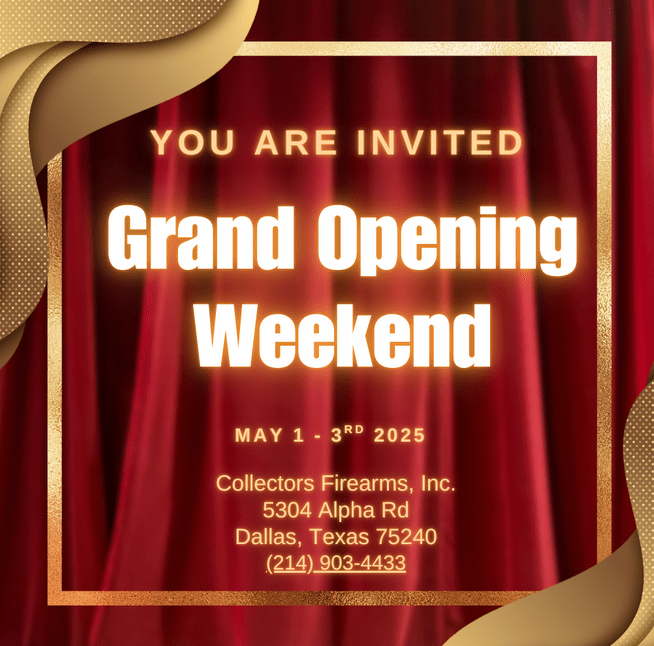
[Le Deep Sigh]

My favorite toy
In my Inbox:

[Le Deep Sigh]
As I wrote earlier: if they’re old enough to have consensual sex, to vote, to be drafted, to sign binding contracts and all that goes with being legally adults, they should be old enough to own and carry guns, kinda like the Second Amendment provides*.
As Iowans have just passed into law, and every state should follow suit.
*Okay, I know that when the Constitution was written and ratified, the legal age of majority was 21 — at least when it came to voting and getting married without parental consent. But seeing as at that time you could serve in the citizen militia at age 16, let’s not go down that rabbit-hole, shall we?
Today’s time is sufficient, and I’m fine with 18.
I keep thinking of the time when my kids were at college, had night classes and had to walk unarmed to their cars in badly-lit parking lots, forced to do so by stupid laws that forbade carrying guns on campus, and gun carry denied to them in toto because of their age.
And they were the law-abiding ones; their 50-something Dad was the lawbreaker, as he carried a gun onto campus every time he went there, despite the law.
I should point out that I also had a mental plan in the event of a campus shooter starting his bullshit if I were in a lecture or seminar: tell everyone — lecturer included — to overturn their desks and take cover behind them, while staying out of my line of fire pointing at the classroom door.
I remember telling one of my erstwhile professors this some time after I graduated, and he thanked me.
It has always pained me to sell a gun. There are a couple of exceptions to this, of course: when you can’t shoot the thing for toffee, when it beats your hand or shoulder up too much, when its ammo is too costly, and so on.
Then there’s the most common reason to sell a gun: financial necessity. But if that necessity forces one into selling a gun, then all sorts of reasons come into play when deciding which gun or guns to sell.
The first reason is sentiment. There are guns that I love to shoot, love to own, and I shouldn’t have to explain this to anyone here. Everyone has possessions that they continue to keep, beyond all reason — overflowing basements, attics and storage facilities all bear witness to this phenomenon — and guns are no different. As an example, let me take the gun which I probably love the most, my Springfield 1911: I keep it despite its ammo being expensive (relative to other calibers), despite the fact that it beats my hand up every time I fire off more than a box of ammo, and despite the fact that every time I holster the damn thing, I have to tighten my belt up by a notch (and sometimes two) because the damn thing is so heavy. But all those are burdens which I bear gladly, because at the end of the day, my 1911 satisfies me in so many ways: it works as well or better than any gun ever made, its cartridge works as well or better than any cartridge ever made, it’s a simple and old-fashioned answer to an eternal question, and whenever I walk outside without it I feel vulnerable. (I know, my .357 Mag revolver is a decent substitute — for all the same reasons — but I’m not Jerry Miculek, so I’ll always be able to shoot the 1911 faster than any revolver.)
My 1911 is unquestionably the last gun — of any kind or chambering — that I would get rid of, and I cannot think of any reason other than death that would make me do so. I have two 1911s, of course, because as any fule kno, two is one and one is none: even John Moses Browning’s masterpiece has been known to fail, after all. And yes [sigh], if I’m going to be away from home for a long time (road trip, etc.), I carry both. one on each hip, if for no other reason than balance.

All that is the long way round to explaining why I have more .45 ACP ammo in Ye Olde Ammoe Locquere than any other caliber except .22 LR. I have .45 ammo that I can’t shoot anymore because the 230gr. FMJ absolutely destroys my wrist after about a box or so, but I still have hundreds of rounds thereof because if push came to shove, I’d shoot it despite the pain because then I’d be in extremis. I have more .45 ACP ammo on hand than I could reasonably be able to shoot for the rest of my life — a statement all the more sadly true the older I get.
Which leads me to the next question: which guns am I unlikely to need as I reach my appointment date with my old companion, the Grim Reaper? That question has proved surprisingly easy to answer, which is why so many of my rifles recently went on the block. I’m never going to go hunting again; that itch has been well and truly scratched because I’ve killed enough game to satisfy just about anyone, and I find myself increasingly reluctant to shoot birds — so my Bucket List item to go shooting high birds with Mr. Free Market at some titled toff’s estate is probably going to remain unchecked. So all my hunting rifles have gone bye-bye, along with a very satisfactory quantity of ammo to feed them.
Which leaves the AK-47. I keep this for completely different reasons than I keep the 1911: it is the ultimate SHTF gun, the gun which, as the man said, you’d want when civilization has crumbled, the jungle and its bunnies have taken over, and you need more firepower (and reach) than your handgun provides. As with the .45 ACP, I have way more 7.62x39mm ammo than I’m ever likely to shoot in my lifetime, but that’s just a factor of my shortage fear: over the years, every time some gun-control advocate has spewed his vile agenda, I’ve bought another few boxes or so of “39”, which is why the locker still can’t be carried except by crane or forklift. It’s the reason behind National Ammo Day, and that reason remains as valid today as it was back then.
And that’s pretty much it. My bedside gun, the S&W Mod 65, requires little restocking because back during the Dubya decade I found an unbeatable deal on Winchester 110gr, and I bought about ummm four large ammo cans’ worth for practice. (At today’s prices — eeek! — that sounds indulgent, but that’s not what I paid for it then, so it still serves as practice ammo when I feel the need to shoot .357 Mag, which isn’t very often.) I have a modest supply (about a thousand rounds) of .38 Special ammo which serves as both practice ammo for the Mod 65 and my backup Mod 637, along with some good Hornady hollowpoint self-defense ammo for the latter. I hardly ever practice — maybe every other month or so — with both revolvers because they are, in the end, guns intended to be used at halitosis range so accuracy isn’t really at a premium. Those couple-thousand .357 and .38 rounds are more than I’ll ever need.
And that’s it, more or less.
Alert Readers will note that in all the above, I’ve made no mention of plinking and its concomitant ammo, .22 LR. This is because (repeat after me): .22 firearms are not guns, but household appliances and tools like a frying-pan or a vacuum cleaner; every home should have at least one of them, and .22 ammo is therefore a household commodity like sugar, salt or coffee.
With rimfire ammo, then, there are no limits. In my case, I have jillions of rounds thereof because I love shooting it, I shoot it often, and it’s excellent practice as well as fun.
For those Readers who are at my stage of life and at my stage of shooting preference, feel free to use the above as a guide, if you wish. For younger Readers who still have the hunting urge and so on, feel free to set your own limits when it comes to both the variety of guns and the ammo required. In my own case, I used to have at least 500 rounds for each of my other guns, and a little less for each of the mil-surps which I used to collect back then (and which I seldom fired in any event).
In the end, it’s your self-defense, your survival and the guns which must guarantee both. For those, you need not five or six months’ supply, but as much as you would need for a lifetime of shooting, shortages be damned. You yourself must decide what works for you, so plan accordingly.
Finally, some here might think that I’m preaching to the choir on this topic, and I hope I am. In that case, you can use it as confirmation that you’ve done the right thing; if not, you can use it as a guide to your goal stock amount.
I’ve often spoken about how a specific .22 rifle or pistol will have a “preference” for a specific kind of ammo. Last time I said that, I got an email from Reader Don K., who asked simply: “Got the targets from that exercise?”
Well, it’s taken me nigh on three days to find it, but I have.
The test was done indoors at the DFW Gun Range in Dallas, back in 2003 or 2004. Here’s the rifle used in the test, my Marlin 880 SQ topped with a 4x fixed scope (don’t remember the brand, sorry — I’ve since replaced it with the variable Bushnell in the pic):

…and here’s the ammo I tested:
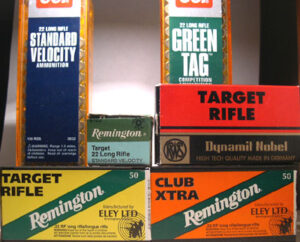
I don’t remember the distance — I think it was 25 yards — but it’s irrelevant because the 1″ targets were all stuck on the same piece of paper.
I first checked the scope’s zero by firing a 5-shot string of my go-to .22 LR (CCI Mini-Mag High Velocity) just to set the scene, so to speak:
 …and then I got serious.
…and then I got serious.
The barrel was allowed to cool between each 5-shot string, and one of the range guys loaded each mag for me so that I never knew which ones I was shooting at any given time. All shots were aimed-deliberate (i.e. not timed), and the scope was never adjusted in any way during the shoot. For clarity, the results are listed clockwise as in the picture above, but I don’t think that’s the order in which I shot them. When I say in comments that the shot “felt good”, it means that as far as I could tell, it should have hit the point-of aim, i.e. the bottom of the little black diamond.
CCI Mini-Mag Standard Velocity
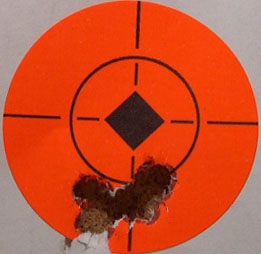
(no flyers called; all felt good)
Remington Target:
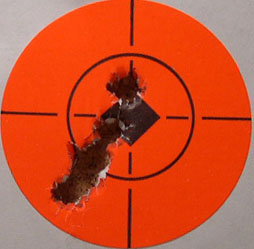
(the 12 o’clock miss was a called flyer)
CCI Green Tag:
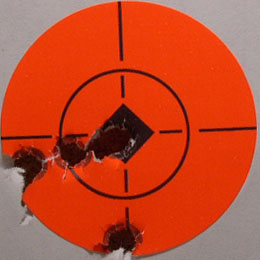
(the 6 o’clock miss was a called flyer)
RWS Dynamit Nobel Target Rifle:
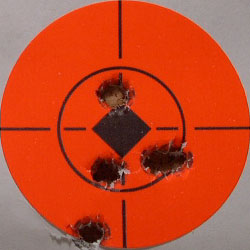
(no flyers called; all felt good)
Remington Eley Club Extra:

(no flyers called; all felt good)
Remington Eley Target Rifle:
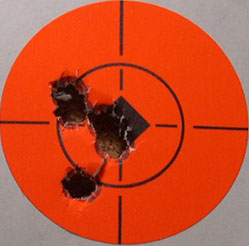
(no flyers called; all felt good)
So: same gun & scope, same shooter, same distance, same session… and different results.
I have to say that my memory tells me that I was most surprised / disappointed by the Green Tag and the Dynamit Nobel results, and most impressed by the Remington Eley Target Rifle. Here’s why.
As you become more and more accustomed to shooting .22 LR, you will find that it becomes easier within a string to call a “light” or “heavy” strike, caused by a lighter or heavier powder loading respectively. You can pretty much overcome this variance by weighing each round before shooting it, by the way, but I didn’t do that before this range test. Perhaps I should have, but I assumed that spendy target ammo should all be consistent within a box; well, they weren’t. When I later shot off some Green Tag, I could tell that at least two out of seven rounds felt “light”, which frankly is unacceptable for premium ammo. (Why seven? That’s what the magazine holds.)
All the Eley Target Rifle rounds felt absolutely consistent when fired, so that seven o’clock “flyer” is the fault of Yours Truly.
Anyway, that’s how that ammo worked for me, in that rifle. I have no doubt that the results might be different in another rifle, in the hands of another shooter perhaps, but that’s the fun of the thing, isn’t it?
Addendum: here’s a consecutive set of targets I also found (from a range session at about the same time as the above test) which show the benefit of practice and concomitant familiarity. All three 10-round strings were fired offhand from my then-new Ruger MkII Target Bull Barrel pistol, with the same ammo, distance unknown.
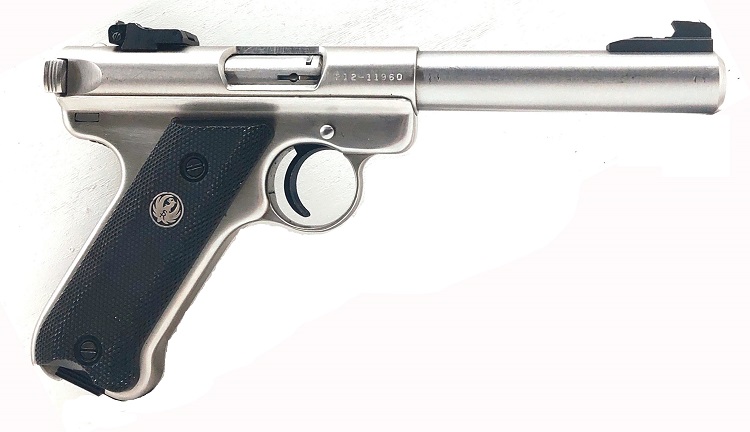
It was the first time I’d ever fired that gun.

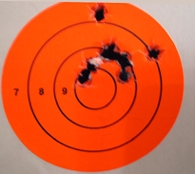
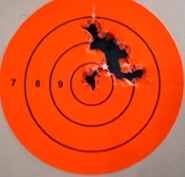
Note the tightening of the group as I got more in tune with the trigger. (I wish I could still shoot that well, but two decades or so have had their way with my eyes, damn it.)
I managed to find the relevant Dead Tree issue of USCCA’s Concealed Carry Magazine, where Tami Keel (in a piece entitled “Stay Stocked”) talks about the vagaries of ammo supply, and keeping yours at a decent level.
Establish A Buffer: work out how much ammo you typically shoot off in a month or so. The higher the amount (duh), the more critical it is to replenish that ammo while it’s there to be had. Tami’s experience is that a 3-6 month stock level should be enough for you to ride out most ammo shortages in that caliber. Mine is somewhat higher (especially in .45 ACP, of course), but while gritting my way through the Great Covidiocy Shortage, I did manage to emerge with about a 4-month “forward” supply simply by shooting smaller amounts per session. (The old days of 300-round sessions with the 1911 are well in the past anyway, because Olde Phartte Wrysts.) Obviously, if you only pop off a box of .30-30 a year, whether hunting or just keeping in practice, your 100-round supply will last you (uhhh carry the three) 5 years. It will be a totally different scenario with your AR-15 (5.56mm poodleshooter), of course, but an adequate supply of said ammo will take care of most shortages — and it helps that most AR-15 owners keep a boatload of ammo on hand anyway. Like I with my 1911, if you manage to keep your range session to (say) four mags’ worth instead of the usual six or eight, your 1,000-round reserve (“buffer”) supply will last a long, long time.
Conversions And Duplicates: I covered this topic in Part 1. Tami notes, however, (and I absolutely agree) that if an ammo shortage drags on and on even these offbeat cartridges will start to disappear from the shelves. Get ’em while they’re hot — or rather, before they start getting hot.
“Die Time”: Ammo suppliers typically set up their production lines with a bias towards the more-popular calibers (e.g. more 9mmP than .380 ACP), but when demand surges during Covidiocy-type panics, they’ll retool their .380 lines to produce more 9mmP, which in turn will lessen the supply of .380 ACP. If you have both — say, for primary and backup purposes — you may need to have a proportionately larger stock of .380 ACP than the shooting of the latter may justify, because its supply is going to run short for a lot longer than the 9mm P. All part of the balancing act.
Reloading: I don’t have to tell any reloaders about the shortage of primers during the Covidiocy, nor of the hostile intent of the anti-gun set towards people having the means of self-sufficiency in general. Suffice it to say that in future Dark Times — and we’d be foolish to assume there won’t be any such ever again — I can see anti-gunners trying to restrict the sales of bulk powder because all that Eeevil Explosive Stuff is dangerous, don’t you know, and we need to Protect Innocnt People From Huge Explosions. So stock up on both primers and powder during the Good Times of strong supply and lower prices; those 5,000 small primers in your workshop are going to evaporate quicker than you think.
Rimfire (or, as Tami terms it, “Embacing Rimfire“): Running out of rimfire ammo is as foolish as running out of salt, flour and sugar. Having a few thousand rounds of .22 LR may sound like a lot, but if your fun plinking time with the kids / grandkids burns through a 500-round brick per session — and it probably will, or should — that’s not a whole bunch of plinking time to go by before the cupboard is bare. So the next time you’re at Bass Pro or wherever and you see a decent price on .22 ammo, imagine the Ghost Of Kim standing behind you whispering “Do it, do it, my son” and fill your basket thereof. Or if you’re doing some online purchasing of your regular .45 or 9mm, spare a thought for rimfire, and add a brick or two before you click “Buy Now”. (This is not a brag, but someone did ask me the other day exactly how much .22 ammo I had on hand, and I didn’t have the faintest clue. So being a conscientious sort, I did a quick inventory the next morning and discovered that I had just over 10,000 rounds of plinking ammo, and 12,000 rounds of the serious kind — CCI Mini-Mag, my go-to feed when I’m trying for the “o” in the Coca-Cola can as opposed to just the can itself when plinking. I need more plinking stuff.)
According to a recent search on AmmoSeek, I see that Aguila is having something of a sale at the moment, and it’s going at under 4 cents / per round at several outlets. CCI Mini-Mag is around 5 cents, and all the others are between those two. Eley, by the way, is under 10 cents per, for probably the first time since the early 2000s (but frankly, that’s only for the ultra-serious target shooters; the Son&Heir does perfectly well in competitions with Federal Gold Match for about the same cost as Eley, AND Federal is made in the USA).
Now off on a semi-related tangent, as is my wont when talking about guns and such.
During that inventory, I also saw that I had a few hundred rounds of CCI Green Tag left (20 cents per, ugh), which I need to test against the Mini-Mag in a couple of my rifles acquired since last I did the comparison (executive summary: the Green Tag was not appreciably more accurate in my guns* than the Mini-Mag at the time, but I’ve acquired a couple different guns since then).
Is that a range session calling me in my little (tinnitus-afflicted) ear?
I believe it is. Hello, ladies:


*Your experience and guns may vary: rimfire guns (rifles and pistols) are notoriously picky about which ammo they shoot the best — even guns that moved consecutively off the same assembly line will likely be different in their preference — so get out there and do some testing.
In a Dead Tree magazine (ergo no link, sorry), I remember reading that Tami Keel talked about ammo shortages and one’s preparation for them, and I’ll talk about that in another post after I find the mag.
She also addressed the issue in an earlier piece in Shooting Times (talking about the Great Covid Ammo Panic) and noted:
Retail stocks of common handgun calibers, such as .380 ACP, 9 mm, .40 S&W and .45 ACP, were quickly depleted.
Which they were. However, she went on to discuss other, less popular calibers, and noted that stocks of stuff like 9x18mm Makorov were less affected — and swapping out the .380 barrel in a Glock 42 for a different one in said chambering meant that one might be less affected by ammo shortages.
I myself saw that when I went to the local Scheels store during the Great Covidiocy, among the otherwise-bare shelves were plentiful supplies of esoteric calibers like .460 S&W, which makes me ponder the question (as Tami did):
Is it worth getting a gun chambered in an offbeat caliber as a backup for one’s regular (for example) 9mmP or .45 ACP?
It’s an interesting thought. Ordinarily, I myself would not be in the market for a gun chambered in, say, .44-40; but faced with a shortage of my regular ammo, that venerable cowboy boolet would sure as hell make a decent backup — especially if one had a rifle chambered for the same cartridge.
So let me look at a couple of “companion” options.
I’ve written before about budget-gunmaker Rossi’s R92 lever rifle, but specifically about its desirability when chambered in .357 Mag — one of those calibers that were severely affected by the Covidiocy shortages.

However, the R92 can also be had in .454 Casull (which can also handle the .45 Colt easily), and when paired with a Magnum Research BFR:
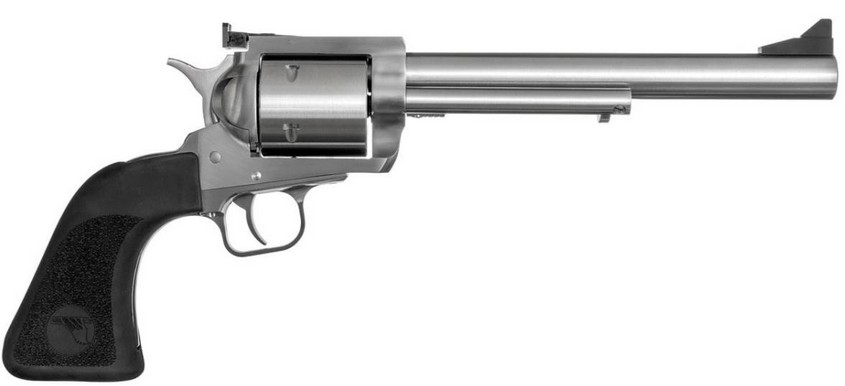
…that’s a hell of a combination. Manly, even. (And .45 Colt is another cartridge that may not be too vulnerable in a supply shortage, but maybe more so than the .454 Casull.)
How about the .350 Legend? (Also known as the .45-70 Govt’s little brother.) I also note that Hornady makes a subsonic variant…
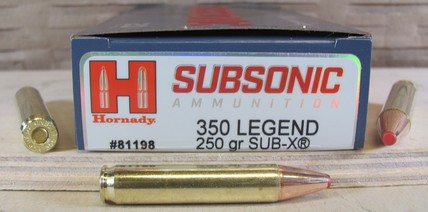
Here we have two outstanding choices — the S&W Model 350:
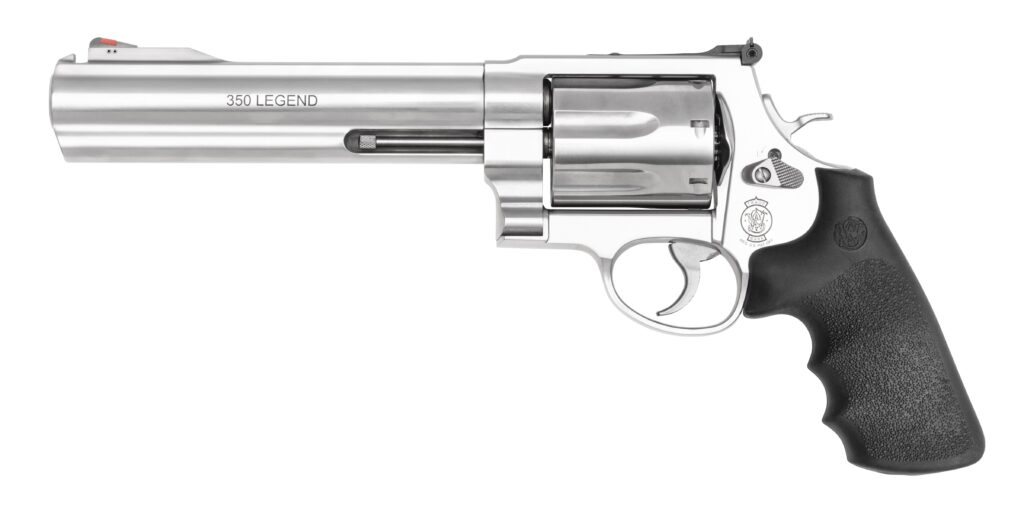
…which can be coupled with (say) a semi-auto Ruger AR556 MPR rifle:

…or the bolt-action Howa Mini-Action:

All three look quite toothsome, don’t they?
Remember, in both the above two calibers, we’re not talking about an “everyday” shooting gun: we’re talking about having a gun, or pair of guns, that will do duty in a pinch and which will probably not fall foul of ammo supply shortages during a period of panic. (That the .350 Legend is not a bad choice for close-range hunting is a feature and not a flaw.)
Feel free to add other such cartridge choices in Comments. I’ve talked about a rifle / handgun pairing, but that’s not a prerequisite for this exercise. You can go with handgun-only or long gun-only.
Afterthought: I know, I know; one should always have enough ammo to withstand a temporary shortage — exactly how much, I’ll cover in that follow-up post — but hey, it’s a nice exercise anyway.